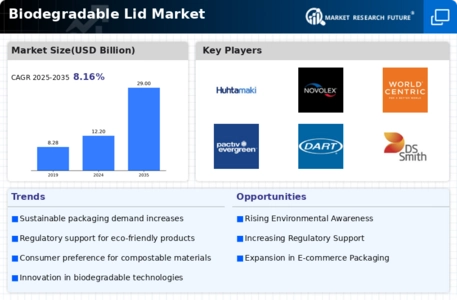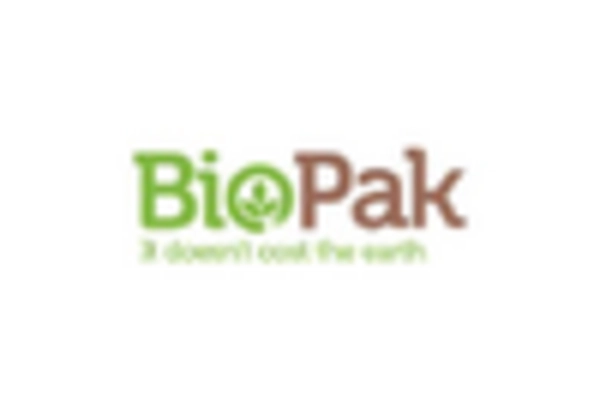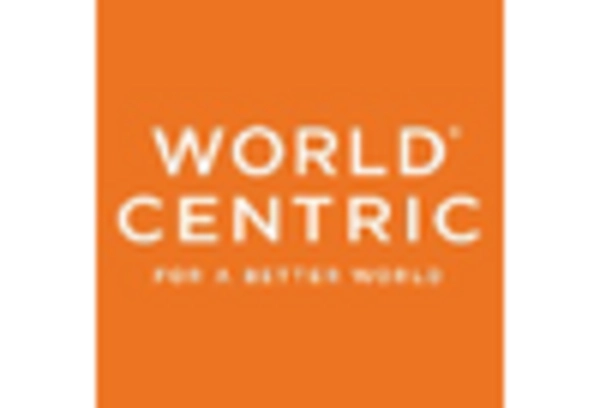Rising Environmental Awareness
The increasing awareness regarding environmental issues appears to be a primary driver for the Biodegradable Lid Market. Consumers are becoming more conscious of their ecological footprint, leading to a heightened demand for sustainable packaging solutions. This trend is reflected in market data, which indicates that the biodegradable packaging sector is projected to grow at a compound annual growth rate of approximately 10% over the next five years. As consumers actively seek alternatives to traditional plastic, businesses are compelled to adapt their product offerings. This shift not only aligns with consumer preferences but also enhances brand reputation, as companies that prioritize sustainability are often viewed more favorably. Consequently, the rising environmental awareness is likely to propel the growth of the Biodegradable Lid Market, as manufacturers strive to meet the evolving expectations of eco-conscious consumers.
Consumer Preference for Convenience
The growing consumer preference for convenience is likely to play a pivotal role in shaping the Biodegradable Lid Market. As lifestyles become increasingly fast-paced, consumers are seeking packaging solutions that offer ease of use without compromising on sustainability. Biodegradable lids, which provide the convenience of single-use products while being environmentally friendly, are gaining traction among consumers. Market data suggests that the convenience factor is a key driver for the adoption of biodegradable packaging, particularly in the food service industry. As restaurants and food delivery services prioritize eco-friendly options, the demand for biodegradable lids is expected to rise. This trend indicates that the Biodegradable Lid Market may continue to expand as businesses cater to the evolving preferences of consumers who value both convenience and sustainability.
Government Regulations and Policies
Government regulations and policies aimed at reducing plastic waste are likely to significantly influence the Biodegradable Lid Market. Many countries have implemented stringent regulations to limit the use of single-use plastics, thereby creating a favorable environment for biodegradable alternatives. For instance, legislation mandating the use of compostable materials in food service packaging has been enacted in various regions. This regulatory landscape not only encourages manufacturers to innovate but also provides a competitive edge to those who comply with sustainability standards. Market data suggests that regions with strict environmental regulations are witnessing a faster adoption of biodegradable products, including lids. As governments continue to prioritize sustainability, the Biodegradable Lid Market is expected to experience accelerated growth, driven by compliance with these evolving regulations.
Corporate Social Responsibility Initiatives
Corporate social responsibility (CSR) initiatives are increasingly influencing the Biodegradable Lid Market. Companies are recognizing the importance of sustainability in their business models and are actively seeking to reduce their environmental impact. This shift is often driven by consumer expectations, as brands that demonstrate a commitment to sustainability tend to foster greater customer loyalty. Many organizations are now incorporating biodegradable packaging solutions, including lids, as part of their CSR strategies. Market data reveals that businesses that prioritize sustainable practices are likely to experience enhanced brand equity and market share. As more companies adopt CSR initiatives focused on environmental stewardship, the demand for biodegradable lids is expected to grow, further propelling the Biodegradable Lid Market.
Technological Advancements in Biodegradable Materials
Technological advancements in the development of biodegradable materials are emerging as a crucial driver for the Biodegradable Lid Market. Innovations in material science have led to the creation of new biodegradable polymers that offer enhanced performance characteristics, such as improved barrier properties and durability. These advancements not only make biodegradable lids more competitive with traditional plastic options but also expand their applicability across various sectors, including food and beverage packaging. Market data indicates that the introduction of novel materials is expected to contribute to a significant increase in market share for biodegradable products. As manufacturers invest in research and development to harness these technologies, the Biodegradable Lid Market is poised for substantial growth, driven by the demand for high-quality, sustainable packaging solutions.


















Leave a Comment